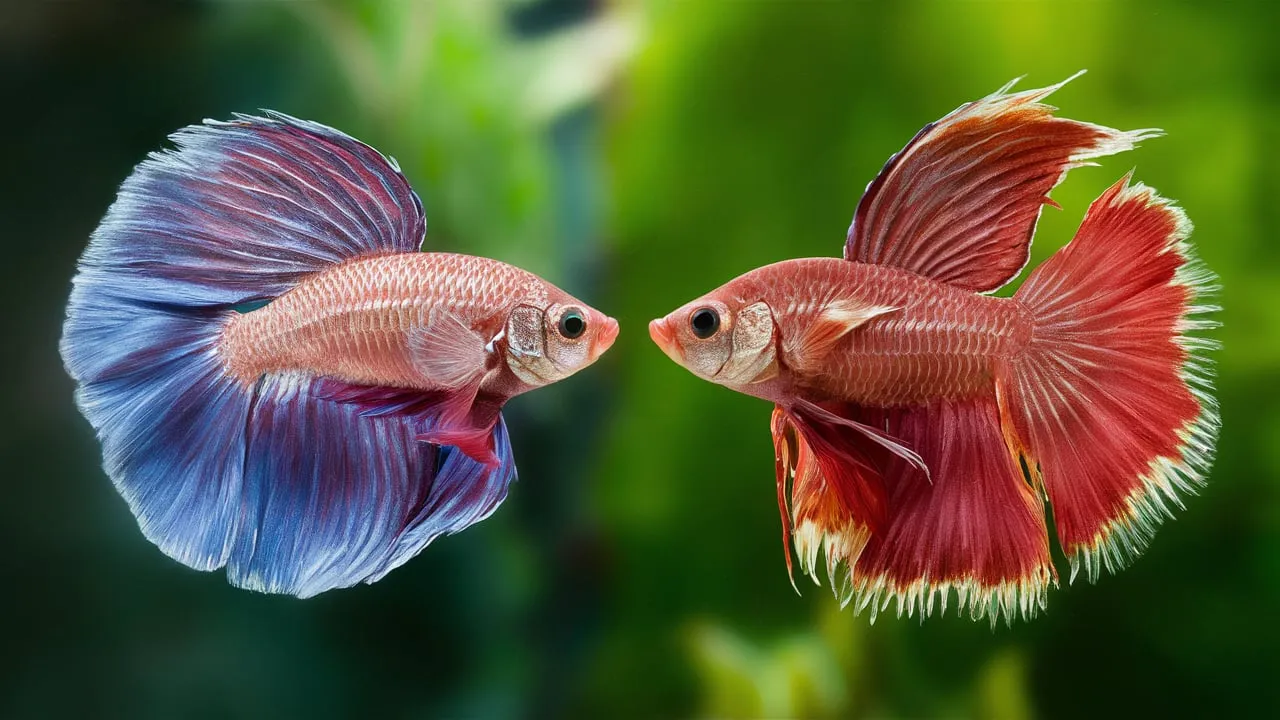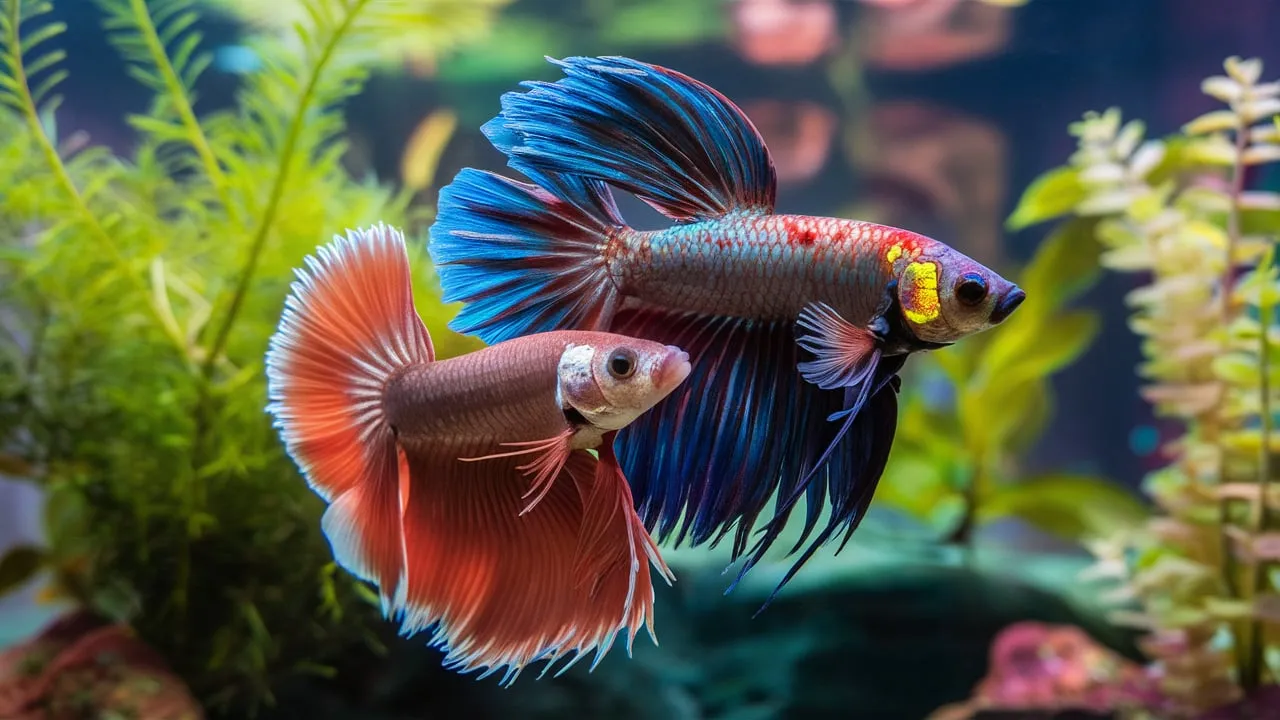Male And Female Betta Fish are popular aquarium inhabitants known for their vibrant colors and unique personalities. At Betta Fish Guide, we explore the key differences in appearance, behavior, and care requirements between male and female betta fish.
Distinguishing Male and Female Bettas
The most obvious difference between male and female bettas is their appearance. Male bettas are generally more flamboyant and striking, while females are more subtle and demure.
Male Betta Fish: The Showstoppers
- Fins: Male bettas have long, flowing fins, including a long dorsal fin, a flowing anal fin, and a pair of long, pointed pelvic fins. These fins are often brightly colored and add to their majestic appearance.
- Body Shape: Male bettas typically have a more elongated body shape compared to females.
- Coloration: Male bettas are known for their vibrant and diverse colors, ranging from deep reds and blues to striking greens and oranges. They often have iridescent scales that shimmer in the light.
- Aggressive Behavior: Male bettas are known for their territorial nature and will often display aggressive behavior towards other males.
Female Betta Fish
- Fins: Female bettas have shorter, more rounded fins compared to males. Their dorsal fin is shorter, and their anal fin is rounded.
- Body Shape: Female bettas have a more compact and rounded body shape compared to males.
- Coloration: Female bettas are often more subtle in their coloration, with muted tones of blue, green, or orange. They may have some iridescent scales but not as prominently as males.
- Peaceful Behavior: Female bettas are generally more peaceful than males and can often be kept in groups.

Understanding the Behavioral Differences
While appearance is a good starting point for distinguishing male and female bettas, their behavior also offers valuable clues.
Male Betta Fish
- Aggressive Display: Male bettas are known for their aggressive displays, which involve flaring their fins, puffing up their bodies, and sometimes even biting. They will often fight with other males for territory and dominance.
- Nest Building: Male bettas are responsible for building bubble nests, which they use to attract females and protect their eggs.
- Courtship Rituals: Male bettas have elaborate courtship rituals that involve displaying their fins, circling females, and blowing bubbles.
Female Betta Fish
- Peaceful Nature: Female bettas are generally more peaceful than males and can often be kept in groups. They are less likely to display aggressive behavior.
- Egg Laying: Female bettas lay eggs, which are fertilized by the male. They may also help the male with nest building and egg care.
- Parental Care: Female bettas may exhibit some parental care, particularly in the early stages of egg development.
Tank Setup and Care
Understanding the differences between male and female bettas is essential for creating a suitable environment for them.
Male Betta Fish
- Single Tank Setup: Male bettas are typically kept in single-tank setups to prevent aggression.
- Large Tank Size: A tank size of at least 5 gallons is recommended for a single male betta.
- Hiding Places: Provide plenty of hiding places like caves, plants, and driftwood to reduce stress and aggression.
- Regular Water Changes: Male bettas are sensitive to water quality, so regular water changes are essential.
Female Betta Fish
- Group Housing: Female bettas can often be kept in groups of 3-5 females in a larger tank.
- Larger Tank Size: A tank size of at least 10 gallons is recommended for a group of female bettas.
- Plenty of Plants: Provide ample plants and hiding places to create a sense of security and reduce aggression.
- Close Monitoring: While female bettas are generally peaceful, it’s important to monitor them closely for any signs of aggression.

Choosing Between Male and Female Betta Fish
When deciding whether to keep male or female betta fish, consider the following factors:
Aesthetic Preferences
If you’re primarily interested in vibrant colors and flowing fins:
- Male bettas typically offer more visual appeal
- Greater variety of tail types and color patterns in males
For a more subtle beauty:
- Female bettas can also display beautiful colors, albeit generally less intense
- Females offer a different kind of aesthetic charm with their rounded bodies and shorter fins
Tank Setup Goals
For a single-fish showcase aquarium:
- Male bettas are ideal centerpiece fish
- Their solitary nature allows for focused care and attention
For community tanks or sororities:
- Female bettas are more suitable for multi-fish setups
- Consider a group of females for a dynamic and interactive display
Maintenance Commitment
Male betta care:
- May require more attention to fin health
- Regular monitoring for signs of aggression or stress
Female betta care:
- Potentially easier maintenance in terms of fin health
More complex social dynamics if kept in groups
Breeding Interests
For those interested in breeding bettas:
- Both males and females are necessary
- Understanding the distinct roles and behaviors of each sex is crucial for successful breeding
Conclusion
Understanding the differences between male and female betta fish is crucial for providing optimal care and creating suitable environments for these fascinating creatures. Whether you’re drawn to the flamboyant displays of male bettas or the subtle charm of females, each sex offers unique characteristics that make them captivating additions to any aquarium.

Related Posts
Betta Fish Lifespan: How Long Do Bettas Live?
How To Clean Filter Socks In The Aquarium? Tips & Tricks
How To Clean Fish Tank Ornaments? Step-by-Step Guide